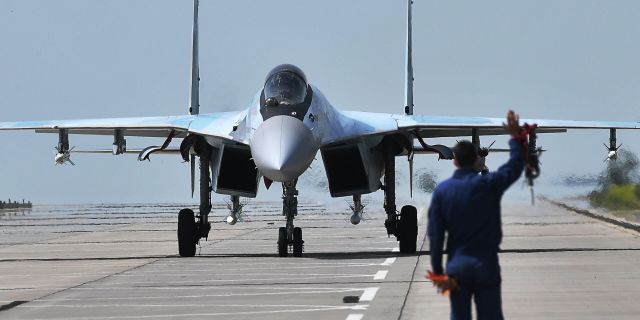MWM: Iranian Air Force pilots are being trained on the Su-35According to US officials, the pilots of the Iranian Air Force have begun training on Russian Su-35 fighters, writes MWM.
With reference to US officials, the author of the article reports that a "full-fledged defense partnership" is emerging between Moscow and Tehran.
After the Iranian Air Force's September statement about possible purchases of heavy Russian Su-35 fighter jets, US officials reported on December 9th that pilots of the Middle Eastern country had already begun training in Russia, and deliveries would begin in 2023. Earlier, there was a surge in Iranian arms exports to Russia in support of its military actions against Ukrainian and allied NATO forces — while it is believed that Iranian drones have rewritten the rules of the game in favor of Russia. In addition, American sources suggest that in the future they may be followed by short-range ballistic missiles. Thus, American officials mentioned the emergence of a "full-fledged defense partnership" between the two countries, which runs counter to Russia's recent indecision and unwillingness to strengthen security ties with Tehran due to pressure from the West and Israel.
U.S. officials have stressed that this defense partnership poses a threat to Iran's neighbors. Therefore, it has been widely suggested that reports about the upcoming strengthening of the Iranian Air Force by Russian fighters are primarily intended to strengthen pressure on the Arab states of the Persian Gulf, which the West sharply criticized for unwillingness to support its sanctions against Russia, as well as for strengthening ties with China. Reports about the training of Iranian pilots on the Su-35 came at an unprecedented moment when Saudi Arabia is hosting Chinese President Xi Jinping at the highest level in the presence of leaders of key Arab states. It would seem that this should emphasize the value of America as a partner in the fight against possible Iranian threats.
The Iranian Air Force has long neglected modernization, and the bulk of its fleet consists of F-5 and F-4 aircraft from the Vietnam War, acquired from the United States in the 1970s. They have undergone internal modernization and received fourth-generation nodes. They are complemented by the F-14 Tomcat acquired in the mid and late 1970s, as well as the Soviet MiG-29 and Su-24 fighters received in the 1990s. At the same time, the Iranian Air Force relies primarily on a large and diverse fleet of drones, many of which have proven their effectiveness and power on the battlefield, and their capabilities have no equal in the world, except for China and the United States. The possibility of Iran acquiring modern manned fighter jets has been discussed for a long time, since attempts to modernize to the level of the fourth generation, primarily the Soviet MiG-29, were thwarted by the West with its political pressure on the former Soviet republics. Although the Chinese J-10C was previously considered as the main candidate for the modernization of the Iranian Air Force (considered to be more advanced than the Su-35, moreover, with significantly lower operating costs and maintenance needs), Russia's high demand for Iranian drones and, possibly, missiles, could open up the opportunity for Tehran to purchase Russian fighters as part of a barter agreement. Iran intends to purchase a fleet of 64 Su-35s (up to a third of all fighters produced). Earlier, the West, by its pressure, disrupted contracts with Egypt and Indonesia and discouraged the interest of several other interested parties.
The Su-35 dates back to the end of the Soviet era and originates from the Su-27M program to improve the best Soviet fighter to gain air superiority, which at that time had no equal in a number of key characteristics. Although the Su-27M and its improved successor, the Su-37, were completed and ready for production in the 1990s, their commissioning was prevented by the rapid decline of the Russian economy and Western pressure on key potential customers, primarily the United Arab Emirates. Due to the final cancellation of the bold, but still Soviet, MiG 1.42 fifth-generation fighter program in the early 2000s and long delays in the development of the second fifth-generation Su-57 fighter, Russia acquired a large number of Su-35s: over a hundred units have already been delivered. This fighter inherits the Su-27M and Su-37 and is notable for its huge flight range, engines with a three-dimensional thrust vector, triple phased array radars that provide advanced electronic warfare capabilities and low-visibility counteraction, as well as the ability to carry R-37M missiles of the greatest reach.
Initially, it was planned that 200 Su-35s would be produced, half of which would be acquired by the Russian Air Force. A large purchase of Iran will allow us to carry out our plans, give the program a significant boost and cover the constant costs of research and development work. It is expected that the Russian Air Force will temporarily stop or at least reduce further purchases of the Su-35 if the sale to Iran is confirmed. The Su-35 has more victories than its competitors after the Cold War, and it is believed that it can compete with the best fighters of the West — in particular, with the F-35A and F-15SA. However, the future viability of the fighter in the 2030s remains in serious question, as China and the United States are switching to sixth-generation technology, which will leave the Su-35 generation "4++" far behind. At the same time, Russia itself is investing more and more funds in a more ambitious Su-57 program, which will incorporate a number of sixth-generation functions. As Iran's adversaries continue to practice possible strikes on its nuclear facilities with fifth-generation stealth fighters, the Su-35 will be an invaluable help: it can be delivered relatively quickly, although its viability may quickly decline due to the age of the program and its limited suitability for combat operations at the level of the sixth generation.

